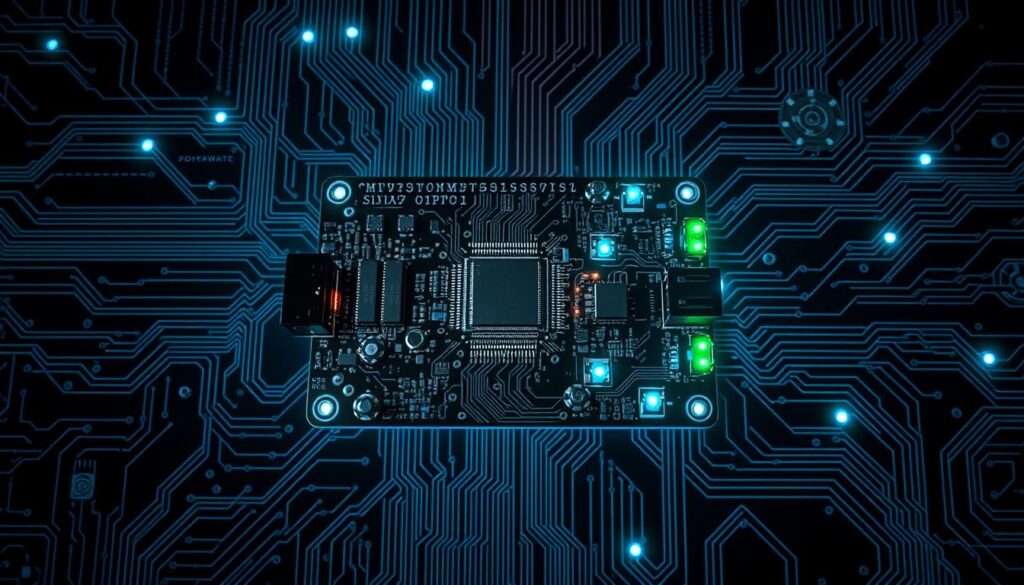The world is moving towards smart homes and robots. The firmware for these robots is key. It makes sure they work well in our homes. But, making this firmware is hard.
Robots like smart vacuums and human-like helpers need special systems. These systems must be strong and safe. But, making them is a big challenge for makers.
Developers face many problems. They need to keep the robots safe from hackers. They also have to make sure the robots use less power. This article will talk about these issues. It will help developers make better robots for our homes.
Understanding Firmware for Home Robots
Firmware: The Invisible Code Controlling Hardware
In the world of home robots, firmware is a key player. It’s the software that controls the robot’s hardware parts. Firmware manages the microcontrollers, sensors, and other parts that make up the robot.
Developing firmware means writing code in low-level languages like C or assembly. This code makes the robot’s systems work better and more efficiently. Home robots use embedded systems, microcontrollers, and real-time systems for tasks like navigation and completing tasks.
Firmware is different from regular software because it focuses on controlling the robot’s hardware. It works as a stand-alone systems and networked systems approach. This ensures the robot works reliably and safely, especially in mobile systems environments.
Understanding firmware helps us see how complex and smart home robots are. Firmware controls the hardware and works with the robot’s software. It’s the invisible code that makes home robots come to life.
Challenges in Firmware Development
Creating firmware for home robots is tough. The firmware complexity in modern systems is high. This makes the development process long and hard.
Firmware relies heavily on hardware. Engineers and designers must work together closely. Home robots face resource limitations like power and memory. This means the firmware must be optimized carefully.
Keeping the firmware compatible across different models is hard. Also, staying ahead of security vulnerabilities is a big challenge. Developers must balance security with performance and efficiency.
| Challenge | Description |
|---|---|
| Firmware Complexity | The intricate nature of modern embedded systems, with numerous interconnected hardware components, can make firmware development a challenging task. |
| Hardware Dependencies | Firmware is closely tied to the specific hardware it is designed for, requiring close collaboration between firmware engineers and hardware designers. |
| Resource Limitations | Home robots often have limited computational resources, memory, and power, necessitating careful optimization of the firmware to fit within these constraints. |
| Compatibility Issues | Ensuring compatibility across different robot models can be a significant challenge for firmware developers. |
| Security Vulnerabilities | Firmware developers must stay ahead of evolving security threats to protect the home robots from cyber attacks. |

To tackle these issues, developers need to know a lot about embedded systems and hardware. Working closely with designers, testing thoroughly, and focusing on security are key. This ensures firmware for home robots is reliable and safe.
Home Robot Firmware Development Process
Creating strong firmware for home robots needs a detailed and organized plan. The process includes several key steps. Each step is designed to make sure the final product works well and meets all requirements.
Steps to Develop Robust Firmware
- Requirements Gathering: First, we need to understand the project’s needs and limits. This means working closely with hardware engineers, users, and others to know what the firmware should do.
- Firmware Design: After knowing what’s needed, we design the firmware’s structure and parts. We choose the right processor, pick the needed peripherals, and plan the overall design.
- Implementation: Then, we write the firmware code, following the best practices. This makes the firmware reliable, efficient, and easy to update.
- Testing: Testing is key to make sure the firmware works right. We do unit, integration, and acceptance tests to find and fix any problems.
- Deployment: After testing, we put the firmware on the home robot. This makes sure it works well with the hardware.
- Maintenance: Firmware work doesn’t stop after deployment. We keep updating it to add new features, fix security issues, or adjust to changes in hardware or software.
By following this detailed process, developers can make firmware for home robots that is strong and reliable. This addresses the special challenges and needs of these complex systems.
| Firmware Development Milestone | Key Activities |
|---|---|
| Requirements Gathering |
|
| Firmware Design |
|
| Implementation |
|
| Testing |
|
| Deployment |
|
| Maintenance |
|
Home robot development
Creating effective home robots is all about balancing hardware and software. These robots show off big leaps in embedded systems, microcontrollers, sensors, and actuators. They’re made to work well on their own, connect to networks, and move easily around the house. They help with many tasks at home.
Writing the firmware is key to making home robots work right. It’s about making sure the robot’s control systems run smoothly. Developers have to think about each robot’s special needs and how to put all the parts together.
One big challenge is making robots work well in real homes. They need to handle delicate, soft, and heavy items with odd shapes. Also, figuring out how to move and handle objects at the same time is tough.
To solve these problems, people are trying new things. They’re using machine learning to teach robots new skills. Building robots for specific jobs, like cleaning or cooking, might also be a good idea.
As we use more robots at home, we need them to get better at seeing, moving, and making decisions. This will help them fit in better with our daily lives. The future of home robots looks very promising, with lots of new ideas to make our lives easier.
| Statistic | Value |
|---|---|
| Japan’s government spending on care robot R&D (by 2018) | Over $300 million |
| Care robots introduced in elder-care institutions in Japan (2019) | About 10% |
| Individuals providing home care with experience using care robots (2021) | 2% |
Firmware Security for Home Robots
Protecting Against Cyber Threats
Firmware is the core software of home robots. If not secured, it can be a big risk. Firmware vulnerabilities let attackers control the robot, making it a cyber threat target. The update process also brings new risks, as weaknesses can let in malicious updates.
Strong security is key to protect home robots from cyber threats. This means using strong encryption, digital signatures, and protecting intellectual property. These steps are crucial in the firmware development and update phases.
- Encryption keeps data safe during updates, stopping unauthorized access.
- Digital signatures check if updates are real and come from a trusted source.
- Intellectual property protection keeps the firmware code safe, stopping unauthorized changes.
By using these security steps, makers of home robots can lower the risk of firmware problems. These methods have been shown to work in real life. They help keep users of home robots safe and confident.
Resource Optimization in Firmware
Embedded systems, like home robots, often have limited resources. These include memory and processing power. Firmware engineers must make the code fit within these limits while still working well. They do this by choosing the right data types, removing unnecessary code, and managing power use.
Memory Optimization
Memory optimization is key. Developers must pick data types that use the least memory but still work well. For instance, using a 16-bit integer instead of a 32-bit one can save a lot of memory.
Data Type Selection
Data type selection is also crucial. Engineers need to look at each module’s data needs. They then choose the best data types to save memory and boost performance.
Peripheral Power Management
Peripheral power management is another important area. Developers must manage the power use of peripherals on the robot. Using smart power-saving methods, like turning off unused peripherals, can make the system more energy-efficient.
| Optimization Technique | Description | Impact |
|---|---|---|
| Memory Optimization | Carefully selecting data types to minimize memory usage | Increased available memory for critical functionalities |
| Data Type Selection | Analyzing data requirements and choosing appropriate data types | Improved system performance and resource utilization |
| Peripheral Power Management | Implementing efficient power-saving techniques for connected peripherals | Enhanced energy efficiency and extended battery life |
By using these optimization methods, firmware developers can make sure home robots work well and efficiently. They deliver the needed functions while using resources wisely.

Energy Efficiency in Home Robot Firmware
Energy efficiency is key for home robots, especially those that run on batteries. The firmware, which controls the robot’s main functions and peripherals, is vital in saving power. Developers can make the code more efficient to use less power and keep the robot running longer. They do this by managing the processor’s power, optimizing peripherals, and scheduling tasks wisely.
Extending Battery Life
Good power management in the firmware can make a robot’s battery last longer. This means the robot can work for more time without needing to be charged often. Several methods can help achieve this:
- Processor Optimization: Engineers can use techniques like dynamic voltage and frequency scaling (DVFS). This helps control the processor’s power use based on the robot’s tasks and conditions.
- Peripheral Power Optimization: Robots have many parts like sensors, motors, and communication modules. The firmware can turn off these parts when they’re not needed to save power.
- Energy-Efficient Firmware: The firmware itself can be made more energy-efficient. This is done through code optimization, managing memory, and smart task scheduling to cut down on power use.
By using these methods in firmware development, robot makers can create devices with longer battery life. This gives users a more dependable and easy-to-use experience.
Conclusion
The global household robots market is growing fast, expected to hit $135.3 billion by 2025. The importance of strong firmware for home robots is clear. Firmware, the code that runs the hardware, is key to these robots working well.
We’ve looked at the big challenges for firmware engineers in making home robots. They face issues like security, using resources wisely, and saving energy. These experts must overcome these hurdles to make firmware that works well and improves the user’s experience.
As the market grows, with new tech like AI and computer vision, the need for advanced home robots will increase. Firmware developers, with the right tools and skills, will play a big role in this growth. They will help create robots that are safe, efficient, and meet many needs, from cleaning to education.

